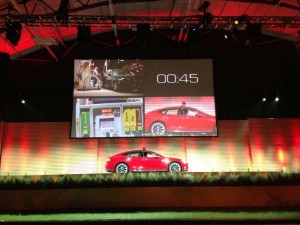
Tesla demonstates the speed of its battery swap system compared to the time it takes to fill up at "the fastest gas station in LA."
Beyond the high cost of electric-vehicle technology, perhaps the biggest turn-off for consumers has been the lengthy time needed to recharge products like the Model S. Or so goes conventional wisdom.
But the maker has set out to show that recharging the sedan doesn’t have to be an obstacle – first by announcing plans for a nationwide, high-speed “Supercharger” network and, now, by demonstrating the ability to swap out a depleted battery for a fresh one faster than you can fill up a gas tank.
After tweeting plans to prove that possibility, Tesla CEO Elon Musk invited journalists and several hundred Model S owners to the factory to demonstrate the new battery-swap strategy. On a video screen overhead, a Tesla employee was shown filling up a car’s gas tank at what the South African-born executive described as “the fastest gas station in L.A.” On stage, a robotic machine automatically removed a Model S battery and replaced it with a fully charged one.
After just a minute and 33 seconds, the Tesla Model S drove off. Another sedan drove on, this one with Musk behind the wheel. His vehicle had required 96 seconds for the swap. The gas-powered vehicle was still filling up as the executive began to address the crowd.
Battery swapping has been a concept frequently discussed but seldom executed by the nascent electric vehicle market because, while it might seem as simple as replacing the batteries in a flashlight, it is far more complex. In most electric vehicles, the battery pack is buried deep inside the car’s structure. In fact, in some products, it is part of the structure itself and essentially a permanent component.
Tesla, however, designed the Model S from the beginning to be removed and quickly replaced.
(Tesla announces plans to expand nationwide Supercharger network. Click Here for more.)
Even so, the process isn’t as simple as it might seem and, where a key advantage of a battery car is the relatively low cost of energy – barely 10% of gasoline on a per-mile basis — the price of doing the swap will be far more expensive, according to Musk. He told the audience it will run about the same as pumping up with 15 gallons of gas, or more than $60 in L.A., though he quickly added that “it will be more convenient.”
Conceivably, a Model S customer could routinely do the swap rather than charging up. That might be particularly useful for owners who live in an apartment or who otherwise don’t have ready access to a charger. Other customers might want to use the battery-swap system when traveling long distances to avoid delays.
Using a 220-volt charger can take a good part of a day to recharge a Model S with the 85 kilowatt-hour battery pack, and even the high-speed Superchargers require 20 minutes.
(New high-speed charging standard could boost demand for battery-cars. Click Herefor the story.)
If a customer only does the battery swap occasionally, they will have the option of keeping the replacement battery and pay a pro-rated charge if it is newer than your original battery. Alternatively, Tesla will bring the original battery back to your home, swap it back in and charge a “transport fee,” Musk explained.
Several weeks ago, Musk announced plans to more than double the size of what will now be a nationwide Supercharger network, ensuring no American Model S owner will be further than 80 to 100 miles away from one of the stations. The plan is to have battery-swap capabilities at the Supercharger stations, something he says will cost about $500,000 per facility to implement.
Each station will have about 50 batteries in stock, and while they will all be new, initially, they could soon get plenty of use, he suggested.
The roll-out will begin with the Supercharger stations on the busy I-5 route between Los Angeles and California, and then expand to other locations, including the Boston to Washington, D.C. corridor.
How successful the plan will be remains to be seen. Project Better Place, an Israeli company that worked with the Renault/Nissan Alliance on a similar battery-swap concept recently announced it would fold shop after finding little consumer interest.
(Project Better Place going out of business. Click Here for more.)
But Tesla has so far been beating even its own expectations, first-quarter sales outpacing projections and helping drive the start-up maker’s first-ever profit. It is funding the Supercharger network and other plans with the anticipated $1.2 billion it expects to raise from a new stock offering.

Is someone going to follow every Tesla owner around the world with spare batteries on a truck or something? If not then Tesla owners must be expected to drive 100+ miles to find a place that can exchange the battery for them. That’s not going to work, IMO. That’s as farcical as quick charging stations that are 100+ miles away from whatever route a Tesla owner is driving.